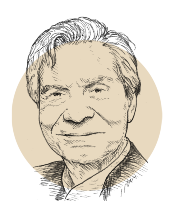France-Amérique: Is Versailles deeply indebted to John D. Rockefeller Jr.?
Catherine Pégard: It certainly is! It is a simple fact that he saved Versailles. When the American philanthropist returned to the Château de Versailles on June 30, 1923 for a gala organized to raise money for the estate’s restoration, he was shocked to find it in such a sorry state. While the palace had not been bombed, it had become dangerously dilapidated. Rain was pouring through the roof, damp had eaten away at the vast living quarters, the gardens were overgrown, and the fountains had run dry. A year later, in a moving letter written to the Council’s President [French Prime Minister] Raymond Poincaré, Rockefeller offered “humbly” to finance the renovation work that war-weary France was unable to afford. “An immense beauty was disappearing and I was devastated,” he later wrote in his memoirs. He personally oversaw the reconstruction until its completion in 1936. In that time, Versailles received almost 40 million francs.
Which other major American philanthropists and foundations helped give Versailles its new lease on life?
To pay tribute to all of them, I would say the American Friends of Versailles – the sister foundation of the Société des Amis de Versailles – which was created in 1998 to encourage contributions from philanthropists in the United States. These patrons are often anonymous, but they continue to prove the special ties between Versailles and America.

Why is the Château de Versailles so dear to Americans?
It is rare that a place symbolizes a relationship between two nations. Americans know that Louis XVI provided crucial support to U.S. independence, and they always stop in the Gallery of Great Battles in front of a painting of the Battle of Yorktown – which marked the American insurgents’ victory against the English. Our common history is filled with shared memories from Versailles. Few people know that Fred Astaire came to sing to GIs on the palace terraces after the Liberation. They do however remember the iconic image of John and Jackie Kennedy being welcomed to the Royal Opera by General de Gaulle in 1961. Today, we regularly receive Leaders from the French-American Foundation, and the Gallery of Great Battles was even decorated in the colors of Ralph Lauren for the 2018 gala hosted his honor. Before the coronavirus brought life as we know it to a halt, Americans were our leading international visitors (16%). As someone born and raised in Normandy, I can say that Versailles has an American presence that is reminiscent of the atmosphere on the D-Day beaches.
How are the American Friends of Versailles currently involved in the site’s ongoing maintenance and restoration?
Last summer, twenty years after the storm that ravaged the Versailles grounds on December 26, 1999, we decided to showcase the estate gardens. People often forget that they are the world’s biggest open-air museum. The American Friends were present throughout the revival process. This year, they are helping to restore the Queen’s Grove, one of Versailles’ most iconic gardens. After being used as one of Marie-Antoinette’s favorite places to take private walks, it became the setting for the sinister affair of the queen’s necklace before falling into disrepair over the years. We decided to restore the natural richness of this area by using the renowned Virginia tulip trees – one of the queen’s favorites. This grove will now be symbolically dedicated to French-American friendship.
Has anyone ever asked to replicate certain rooms or works of art and take them to America?
You could say that Versailles is part of the American landscape! U.S. architects have been inspired by the symmetries and scales of Versailles, which you can see in the city plan of Washington and the grandeur of the Capitol building. The Petit Trianon was regularly copied in the late 19th and early 20th centuries. As recently as last year I received an American from California who wanted to compare the plan with the one for his residence. Today, Versailles is still the symbol of French art de vivre for Americans, right down to its gastronomy. But that’s not all! Younger people are very interested in professions such as fountain building, gilding, gardening, and cabinetmaking, which all make the palace so special and continue to inspire contemporary design.

Versailles: From Louis XIV to Jeff Koons by Catherine Pégard, Assouline, 2020. 234 pages, 895 dollars.
Article published in the August 2020 issue of France-Amérique. Subscribe to the magazine.












